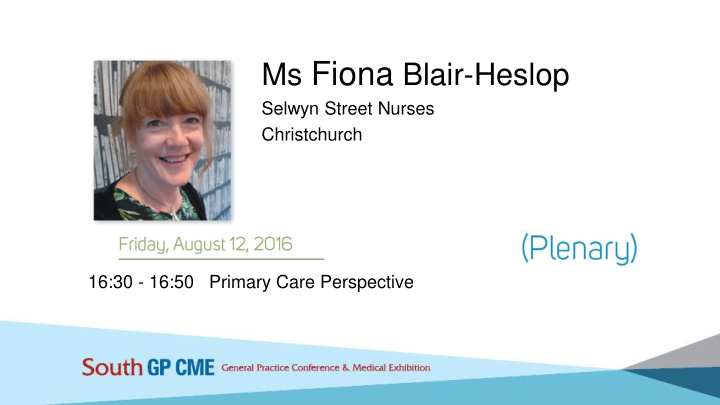



Ms Fiona Blair-Heslop Selwyn Street Nurses Christchurch 16:30 - 16:50 Primary Care Perspective
Primary Care Perspective
Selwyn Village HealthCare 2013, started considering how to better manage COPD within the practice Some ‘Frequent flyers’ requiring high input, feeling we’re perpetuating reliance and ‘fire fighting’ not ‘managing’ or ‘empowering’ Anecdotally under-diagnosing or miss- diagnosing Coding variance
Visit from Respiratory Team CPH December 2013 Focus on case finding – likely under or miss diagnosing COPD. Data Provided included; Smoking rates, Coding, Spirometry, Admissions, Pulmonary rehab rates and Dispensing Coincided with the introduction of Acute Plans for patients at risk of admission
The Practice chose to take this further with a two pronged approach; Develop a practice wide protocol for managing known COPD And Case finding for undiagnosed COPD Quality focus and best practice principles
Protocol Known COPD QB and search to find current patients Review lists Nurse/GP team – frequent attendees, complex, symptomatic, admissions and exacerbations invited in Case Finding QB to find smokers over 40, on a reliever Review notes and post out an offer letter and flyer
Known COPD Nurse previews notes and prepares, requests repeat Spirometry if appropriate to confirm diagnosis and severity 30 min nurse, 15 min GP appt Nurse does physical exam, CAT and mMRC score, checks inhaler technique and changes spacers, and... education, smoking cessation, vaccines, BMI & dietary advice, falls risk, offers pulmonary rehab, medicines management, accessible parking establishes Gold severity group
GP reviews diagnosis, co-morbidities and medications action plan agreed between all parties and scripted separately Nurse gives patient/Family home action plan and also enters into CCMS for view by ED/After Hours Recall on to repeat in 12 months – usually pre winter Patient centred approach
Enablers & what went well Enthusiastic drivers within staff IT Tools – ERMS, ePortal, screening terms, HealthPathways, recurring tasks, QB Acute Plan funding GP Nurse Team approach with specialist support High level of awareness and opportunistic screening, education and intervention
Roll on effect to managing other conditions Patient and family satisfaction - confidence! Better, and innovative use of other PHC services – physio, dietician, resp nurses, PCW, Pharmacy and MMS, falls prevention, CREST, age concern Patients prepared to advocate and mentor others Potential whanau and generational benefit
Barriers, Issues and opportunities Complexity – high level of co-morbidities Dangers of a disease centric approach Patient reluctance – ‘unwanted’ diagnosis Variance of coding and managing Uneven rollout – acute plan Cultural and language issues not addressed – ethnicity, age, gender Staff training and working up to scope
Funding We’re quite good at funding interventions e.g. acute plans Not good at funding prevention e.g. case finding A group of patients need the education and intervention but not an acute plan – therefore no funding New funded COPD meds aren’t helping reduce complexity
Results? Stats a Little better - still not up to predicted rates Big increase in referrals for spirometry and pulmonary rehab Smoking cessation advice up+ GP Nurse team spin offs A platform to launch other disease management – CHF, CRF Raised level of awareness – lots of opportunistic testing and discussions e.g. at triage
Like the rest of general practice; • ‘Its all about people and relationships’ • ‘More than one bite of the apple’ • Team approach is key – all LTC • Cleverness with funding and services
Recommend
More recommend